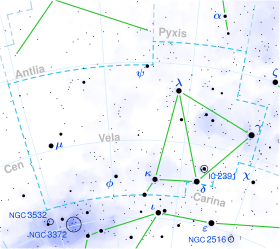Star in the constellation Vela
GX Velorum is a solitary variable star in the southern constellation of Vela . It is visible to the naked eye as a faint, blue-white hued star with an apparent visual magnitude that fluctuates around 4.99. Based upon parallax measurements, it is located approximately 4,200 light years distant from the Sun, and is drifting further away with a radial velocity of +28 km/s. It may be a member of the Vela OB1 association of co-moving stars.
A light curve for GX Velorum, plotted from Hipparcos This object is a massive blue supergiant with a stellar classification of B5 Ia. It is suspected to be an Alpha Cygni-type pulsating variable and ranges in brightness from 4.97 down to 5.04 magnitude. It is losing mass at the rate of (0.40±0.02)×10 M ☉ yr, or one solar mass every 2.5 million years. The star is 8.3 million years old with 35 times the mass of the Sun . It has expanded to around 61 times the Sun's radius and is radiating 214,000 times the luminosity of the Sun from its enlarged photosphere at an effective temperature of 15,000 K.
References
^ Brown, A. G. A. ; et al. (Gaia collaboration) (August 2018). "Gaia Data Release 2: Summary of the contents and survey properties" . Astronomy & Astrophysics 616 . A1. arXiv :1804.09365 . Bibcode :2018A&A...616A...1G . doi :10.1051/0004-6361/201833051 .Gaia DR2 record for this source at VizieR .
^ Anderson, E.; Francis, Ch. (2012). "XHIP: An extended hipparcos compilation". Astronomy Letters . 38 (5): 331. arXiv :1108.4971 . Bibcode :2012AstL...38..331A . doi :10.1134/S1063773712050015 . S2CID 119257644 .
^ Samus', N. N; et al. (2017). "General catalogue of variable stars: Version GCVS 5.1". Astronomy Reports . 61 (1): 80. Bibcode :2017ARep...61...80S . doi :10.1134/S1063772917010085 . S2CID 125853869 .
^ Houk, Nancy (1978). Michigan catalogue of two-dimensional spectral types for the HD stars . Vol. 2. Ann Arbor: Dept. of Astronomy, University of Michigan. Bibcode :1978mcts.book.....H .
^ Ducati, J. R. (2002). "VizieR Online Data Catalog: Catalogue of Stellar Photometry in Johnson's 11-color system". CDS/ADC Collection of Electronic Catalogues . 2237 . Bibcode :2002yCat.2237....0D .
^ Gontcharov, G. A. (2006). "Pulkovo Compilation of Radial Velocities for 35 495 Hipparcos stars in a common system". Astronomy Letters . 32 (11): 759–771. arXiv :1606.08053 . Bibcode :2006AstL...32..759G . doi :10.1134/S1063773706110065 . S2CID 119231169 .
^ Reed, B. Cameron (2000). "Vela OB1: Probable New Members and Hertzsprung-Russell Diagram" . The Astronomical Journal . 119 (4): 1855–1859. Bibcode :2000AJ....119.1855R . doi :10.1086/301313 .
^ Fraser, M.; et al. (2010). "Atmospheric parameters and rotational velocities for a sample of Galactic B-type supergiants" . Monthly Notices of the Royal Astronomical Society . 404 (3): 1306. arXiv :1001.3337 . Bibcode :2010MNRAS.404.1306F . doi :10.1111/j.1365-2966.2010.16392.x . S2CID 118674151 .
^ Haucke, M.; et al. (June 2018), "Wind properties of variable B supergiants. Evidence of pulsations connected with mass-loss episodes", Astronomy & Astrophysics , 614 : 28, arXiv :1902.01341 , Bibcode :2018A&A...614A..91H , doi :10.1051/0004-6361/201731678 , S2CID 126150688 , A91
^ Tetzlaff, N.; et al. (2011). "A catalogue of young runaway Hipparcos stars within 3 kpc from the Sun" . Monthly Notices of the Royal Astronomical Society . 410 (1): 190–200. arXiv :1007.4883 . Bibcode :2011MNRAS.410..190T . doi :10.1111/j.1365-2966.2010.17434.x . S2CID 118629873 .
"GX Vel" . SIMBAD Centre de données astronomiques de Strasbourg . Retrieved 2019-08-16.Eggleton, P. P.; Tokovinin, A. A. (September 2008). "A catalogue of multiplicity among bright stellar systems" . Monthly Notices of the Royal Astronomical Society 389 (2): 869–879. arXiv :0806.2878 . Bibcode :2008MNRAS.389..869E . doi :10.1111/j.1365-2966.2008.13596.x . S2CID 14878976 .
"Hipparcos Tools Interactive Data Access" . Hipparcos . ESA. Retrieved 8 December 2021.
Categories :
GX Velorum
Add topic
Text is available under the Creative Commons Attribution-ShareAlike License. Additional terms may apply.
**DISCLAIMER** We are not affiliated with Wikipedia, and Cloudflare.
The information presented on this site is for general informational purposes only and does not constitute medical advice.
You should always have a personal consultation with a healthcare professional before making changes to your diet, medication, or exercise routine.
AI helps with the correspondence in our chat.
We participate in an affiliate program. If you buy something through a link, we may earn a commission 💕
↑

